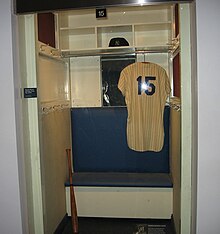Thurman Munson
Born in Akron, Ohio, Munson was selected as the fourth pick of the 1968 MLB draft and was named as the catcher on the 1968 College Baseball All-American Team.
As captain, Munson helped lead the Yankees to three consecutive World Series appearances from 1976 to 1978, winning championships in the latter two years.
He is also the only catcher in MLB postseason history to record at least a .300+ batting average (.357), 20 RBIs (22), and 20 defensive caught stealings (24).
[6] Munson attended Lehman High School, where he was captain of the football, basketball, and baseball teams and was all-city and -state in all three sports.
[10] Munson switched to catcher in his senior year in order to handle the pitching prowess of his teammate, Jerome Pruett (a fifth-round draft pick of the St. Louis Cardinals in 1965 who never reached the majors).
[12] In 2000, Munson was named a member of the inaugural class of the Cape Cod Baseball League Hall of Fame.
He made 97 plate appearances, but drew ten walks and had one sacrifice fly, which gave him 86 official at bats, and allowed him to go into the 1970 season still technically a rookie.
Munson responded by batting .302 with seven home runs and 57 RBIs, and making 80 assists en route to receiving the 1970 American League Rookie of the Year award.
It occurred on June 18 against the Baltimore Orioles when opposing catcher Andy Etchebarren knocked Munson unconscious on a play at the plate, dislodging the ball.
[19] One particular incident that typified their feud, and the Yankees – Red Sox rivalry in general, occurred on August 1, 1973 at Fenway Park.
He responded by batting .302 with 17 home runs and 105 RBIs to receive the American League MVP Award and lead the Yankees to their first World Series appearance since 1964.
Visibly upset by these comments, which he heard as he entered the room, Munson "ripped into Anderson," according to sportswriter Moss Klein.
"[19] When Jackson sent backup catcher Fran Healy to apologize for those remarks, insisting he was misquoted, Munson responded, "For four bleeping pages?!
He was the first catcher to accomplish the feat in three consecutive years since Yankee Hall of Famer Bill Dickey's four straight seasons from 1936-1939, matched only by Mike Piazza since (1996–2000).
The Yankees had lost three in a row, and were in fourth place, eleven games behind the Baltimore Orioles in the American League East heading into the All-Star break in 1979.
His flight instructor Dave Hall spoke well of his ability: "From the onset to completion of training Mr. Munson displayed well above average skills and judgment as a pilot.
"[28] However, in a 2022 tribute piece for his Countdown with Keith Olbermann podcast, sports commentator Keith Olbermann recalled that four months before Munson's death, he was told that Yankee executives were terrified Munson was "not as good a pilot as he thinks he is" and that they were attempting to get owner George Steinbrenner to trade him to Cleveland to get him to stop flying, afraid that he might "wind up killing himself.
"[30] On the afternoon of August 2, 1979, Munson was practicing takeoffs and landings at the Akron-Canton Regional Airport with Hall and friend Jerry Anderson, with whom he had formed a real estate partnership.
[35] The National Transportation Safety Board (NTSB) investigation into the crash stated that the probable cause was "the pilot's failure to recognize the need for, and to take action to maintain, sufficient airspeed to prevent a stall into the ground during an attempted landing.
The pilot also failed to recognize the need for timely and sufficient power application to prevent the stall during an approach conducted inadvertently without flaps extended.
Contributing to the pilot's inability to recognize the problem and to take proper action was his failure to use the appropriate checklist and his nonstandard pattern procedures which resulted in an abnormal approach profile."
Rather than requiring Munson to take a two-week safety class in Kansas, FlightSafety assigned a "traveling instructor" to go on the road with him, and train him between ballgames.
[citation needed] The day after his death, before the start of the Yankees' four-game set with the Baltimore Orioles in the Bronx, the team paid tribute to their deceased captain in a pre-game ceremony in which the starters stood at their defensive positions, save for the catcher's box, which remained empty.
Following a prayer by Cardinal Terence Cooke, a moment of silence and "America the Beautiful" by Robert Merrill, the fans (announced attendance 51,151) burst into an eight-minute standing ovation.
[4] Catcher Jerry Narron, who replaced Munson behind the plate that night,[31] remained in the dugout and did not enter the field until stadium announcer Bob Sheppard said, "And now it is time to play ball.
Teammates Lou Piniella and Bobby Murcer, who were Munson's best friends, gave eulogies at the gathering of 700 at the Canton Memorial Civic Center.
"[42] John also praised him for his leadership, writing that while Jackson led the team when it came to hitting and talking with the press, "in the locker room we looked to Munson.
The plaque bears excerpts from an inscription composed by Steinbrenner and flashed on the stadium scoreboard the day after his death: Our captain and leader has not left us, today, tomorrow, this year, next ... Our endeavors will reflect our love and admiration for him.
[44][45] Steve Rushin, who coined the term in a 2003 Sports Illustrated article, has pinpointed the line as running north of New Haven, south of Hartford, and along the width of central Connecticut.
The couple had been childhood sweethearts; Diana was already signing her name "Mrs. Thurman Munson" back in sixth grade.



